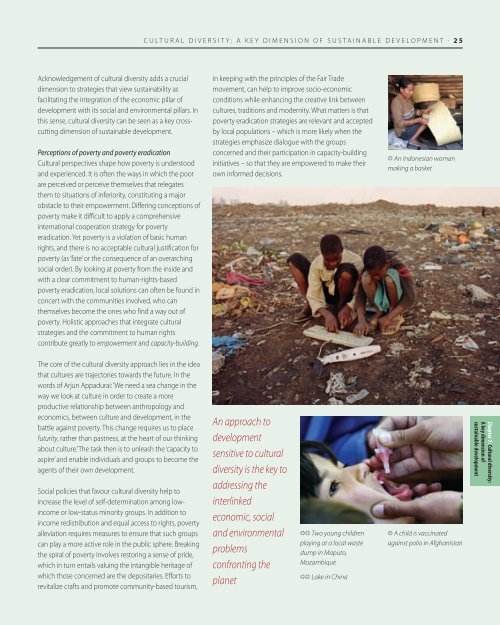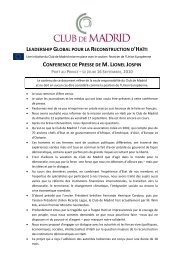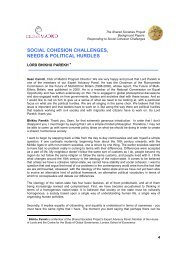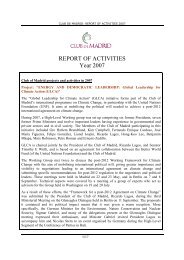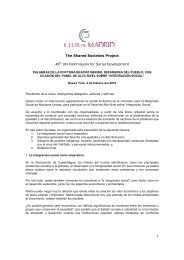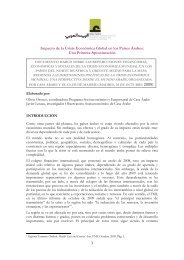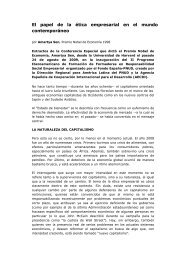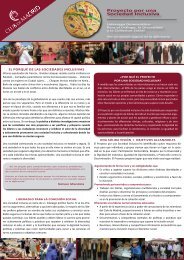Investing cultural diversity and intercultural dialogue - Business and ...
Investing cultural diversity and intercultural dialogue - Business and ...
Investing cultural diversity and intercultural dialogue - Business and ...
Create successful ePaper yourself
Turn your PDF publications into a flip-book with our unique Google optimized e-Paper software.
CULTURAL DIVERSITY: A KEY DIMENSION OF SUSTAINABLE DEVELOPMENT . 25<br />
Acknowledgement of <strong>cultural</strong> <strong>diversity</strong> adds a crucial<br />
dimension to strategies that view sustainability as<br />
facilitating the integration of the economic pillar of<br />
development with its social <strong>and</strong> environmental pillars. In<br />
this sense, <strong>cultural</strong> <strong>diversity</strong> can be seen as a key crosscutting<br />
dimension of sustainable development.<br />
Perceptions of poverty <strong>and</strong> poverty eradication<br />
Cultural perspectives shape how poverty is understood<br />
<strong>and</strong> experienced. It is often the ways in which the poor<br />
are perceived or perceive themselves that relegates<br />
them to situations of inferiority, constituting a major<br />
obstacle to their empowerment. Differing conceptions of<br />
poverty make it difficult to apply a comprehensive<br />
international cooperation strategy for poverty<br />
eradication. Yet poverty is a violation of basic human<br />
rights, <strong>and</strong> there is no acceptable <strong>cultural</strong> justification for<br />
poverty (as ‘fate’ or the consequence of an overarching<br />
social order). By looking at poverty from the inside <strong>and</strong><br />
with a clear commitment to human-rights-based<br />
poverty eradication, local solutions can often be found in<br />
concert with the communities involved, who can<br />
themselves become the ones who find a way out of<br />
poverty. Holistic approaches that integrate <strong>cultural</strong><br />
strategies <strong>and</strong> the commitment to human rights<br />
contribute greatly to empowerment <strong>and</strong> capacity-building.<br />
in keeping with the principles of the Fair Trade<br />
movement, can help to improve socio-economic<br />
conditions while enhancing the creative link between<br />
cultures, traditions <strong>and</strong> modernity. What matters is that<br />
poverty eradication strategies are relevant <strong>and</strong> accepted<br />
by local populations – which is more likely when the<br />
strategies emphasize <strong>dialogue</strong> with the groups<br />
concerned <strong>and</strong> their participation in capacity-building<br />
initiatives – so that they are empowered to make their<br />
own informed decisions.<br />
L An Indonesian woman<br />
making a basket<br />
The core of the <strong>cultural</strong> <strong>diversity</strong> approach lies in the idea<br />
that cultures are trajectories towards the future. In the<br />
words of Arjun Appadurai: ‘We need a sea change in the<br />
way we look at culture in order to create a more<br />
productive relationship between anthropology <strong>and</strong><br />
economics, between culture <strong>and</strong> development, in the<br />
battle against poverty. This change requires us to place<br />
futurity, rather than pastness, at the heart of our thinking<br />
about culture.’ The task then is to unleash the ‘capacity to<br />
aspire’ <strong>and</strong> enable individuals <strong>and</strong> groups to become the<br />
agents of their own development.<br />
Social policies that favour <strong>cultural</strong> <strong>diversity</strong> help to<br />
increase the level of self-determination among lowincome<br />
or low-status minority groups. In addition to<br />
income redistribution <strong>and</strong> equal access to rights, poverty<br />
alleviation requires measures to ensure that such groups<br />
can play a more active role in the public sphere. Breaking<br />
the spiral of poverty involves restoring a sense of pride,<br />
which in turn entails valuing the intangible heritage of<br />
which those concerned are the depositaries. Efforts to<br />
revitalize crafts <strong>and</strong> promote community-based tourism,<br />
An approach to<br />
development<br />
sensitive to <strong>cultural</strong><br />
<strong>diversity</strong> is the key to<br />
addressing the<br />
interlinked<br />
economic, social<br />
<strong>and</strong> environmental<br />
problems<br />
confronting the<br />
planet<br />
LL Two young children<br />
playing at a local waste<br />
dump in Maputo,<br />
Mozambique<br />
JJ Lake in China<br />
L A child is vaccinated<br />
against polio in Afghanistan<br />
Chapter 7: Cultural <strong>diversity</strong>:<br />
A key dimension of<br />
sustainable development


